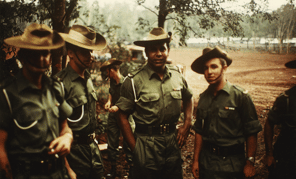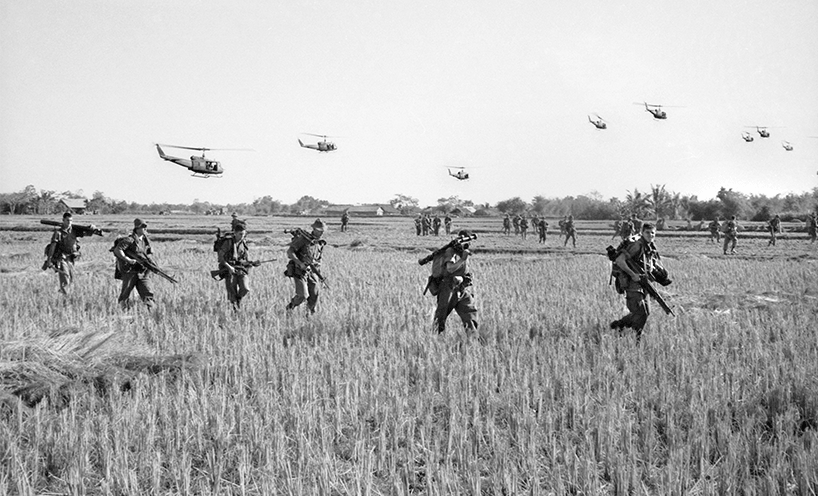
- Conflict:
- Vietnam War (1962-73)
- Services:
- Army, Air Force, Navy
On 3 August 1962, thirty Australian officers and senior non-commissioned officers arrived in South Vietnam’s capital, Saigon. The newly formed Australian Army Training Team Vietnam (AATTV) or ‘Team’ was Australia’s opening gambit in a ten-year military commitment.
Vast tracts of South Vietnamese territory had been rendered ungovernable by Viet Cong guerrillas—insurgents backed by communist North Vietnam. Both Washington and Saigon sought to enhance the fighting capability of its fledgling armed forces and the AATTV was Canberra’s response.
AATTV advisors—working alone or in pairs—were embedded with South Vietnamese units as trainers and field commanders. Their presence in every corner of South Vietnam demonstrated Australia’s commitment to the ANZUS military alliance. The AATTV commitment grew steadily, reaching a peak of 217 advisors by November 1970.
Viet Cong activity and North Vietnamese Army (NVA) incursions into South Vietnam convinced Washington to commit 200,000 ground troops in 1965 to bolster the Saigon regime. The Australian government followed suit, dispatching 1st Battalion, Royal Australian Regiment (1RAR) to Bien Hoa province in June 1965.
Australian military planners sought tactical autonomy in a province with its own seaport. A brigade-sized garrison, the 1st Australian Taskforce (1 ATF) was emplaced at Nui Dat in Phuoc Tuy province, between April and June 1966. 1 ATF would remain Australia’s most significant contribution to the war in Vietnam.
The Royal Australian Navy (RAN) troop transport HMAS Sydney supplied 1 ATF via the province’s major port Vung Tau, where Caribou transports on No. 35 Squadron RAAF had been operating since August 1964. Iroquois helicopters of No. 9 Squadron RAAF, based at Nui Dat, provided further logistic and tactical support.
1 ATF typically comprised two (and between 1968 and 1970, three) battalions of the Royal Australian Regiment, with one artillery regiment, and one squadron each of Centurion tanks, Armoured Personnel Carriers (APC) and Special Air Services (SAS). New Zealand contributed to 1 ATF by providing artillery batteries and infantry companies, which served in Anzac units alongside Australians.
Anzac support troops—engineers, medical, supply, transport, signals and intelligence staff—based at Nui Dat, Vung Tau, Ba Ria and Saigon brought the number of troops stationed in South Vietnam to a peak of 7,672 Australian and 552 New Zealand troops, in 1969. All nine RAR battalions rotated through 1 ATF between 1966 and 1971—with each spending at least one year-long tour ‘in country’.
No. 2 Squadron RAAF, equipped with Canberra bombers, flew strike missions from Phan Rang Air Base, 250 kilometres north-east of Saigon from 1967. RAN destroyers joined United States Navy patrols off the North Vietnamese coast while navy clearance diving teams and a helicopter detachment operated with the United States Army troops from October 1967. The Australian Civil Affairs Unit meanwhile worked to win ‘heart and minds’ with infrastructure and public health and education initiatives.
Australian troops fought communist forces in Phuoc Tuy and the surrounding provinces and were largely successful in reducing communist activity in the province. The most famous battles included Long Tan (18 August 1966), Coral–Balmoral (12 May – 6 June 1968), Binh Ba (6–8 June 1969), and Long Khanh (6–7 June 1971). 1 AFT’s greatest tactical blunder was undoubtedly a 10 km minefield laid from Dat Do to the coast between 1966 and 1967. Viet Cong fighters dug up thousands of ‘jumping jack’ mines which were then reused—inflicting the lion’s share of casualties on Anzac troops thereafter.
Successes and failures aside, the war proved highly unpopular and divisive in Australia. The Viet Cong’s massive 1968 Tet Offensive, though a military failure, convinced many ordinary Australians that decisive victory was impossible. Horrific scenes on television screens, meanwhile, sapped public support further. An Australian anti-war movement gathered momentum and by 1970-71 hundreds of thousands of people were attending Moratorium marches across Australia. Protestors, conscientious objectors, and draft-resisters were fined or gaoled. Soldiers returning to Australia met a hostile reception.
The government responded to public antipathy by steadily withdrawing troops. The last combat troops arrived home in December 1972. The AATTV, the first troops to deploy to South Vietnam, would be among the very last to leave. ‘The Team’ had lost 33 men killed and 122 wounded. Four of its members were awarded the Victoria Cross, the only VCs won by Australians during the war. All told, some 60,000 Australians served in Vietnam between 1962 and 1973. 521 died and over 3,000 were wounded. Controversially, 15,381 of these troops were conscripted national servicemen, of whom 202 were killed and 1,279 wounded.
Author: Neil Sharkey, Curator Shrine of Remembrance
Updated
